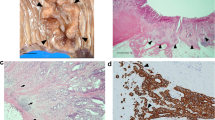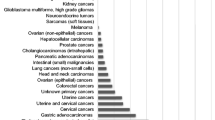Abstract
Integrin-linked kinase (ILK), an intracellular protein with serine/threonine protein kinase activities, plays a key role in integrin mediated cell-excellular matrix interactions, regulating cell proliferation, apoptosis, differentiation, and migration. ILK has been implicated in the development and progression in several malignancies. However, the role of ILK and ILK-mediated epithelial–mensenchymal transition (EMT) in the progression of oral squamous cell carcinoma (OSCC) has not been well understood. Here, by immunohistochemistry, we studied the expression of ILK, Snail, E-cadherin and N-cadherin in 98 primary OSCC specimens and analyzed their correlations with clinicopathologic profiles and clinical outcome. We also investigated the expression of ILK in 42 corresponding lymph node metastases. Positive expression of ILK protein was detected in 87.8 % of the primary tumors and 100 % of metastatic lesions. Increased ILK expression was correlated strongly with enhanced tumor invasion, higher tumor grade, advanced clinical stage, positive lymph node status and increased risk of recurrence. Higher ILK expression was also observed in lymph node metastases in comparison with the corresponding primary tumor. Moreover, up-regulation of Snail and N-cadherin and down-regulation of E-cadherin correlated significantly with both ILK over-expression and tumor invasion. Patients with higher ILK expression exhibited shorter disease-free survival while those with absent E-cadherin expression exhibited shorter overall and disease-free survival. Taken together, our results suggest that ILK may have an important role in progression and metastasis of OSCC, possibly through EMT involving up-regulation of Snail and consequent aberrant expression of E-cadherin and N-cadherin. ILK should be considered as a critical prognostic indicator for patients with OSCC.






Similar content being viewed by others
Abbreviations
- ILK:
-
Integrin-linked kinase
- EMT:
-
Epithelial–mensenchymal transition
- OSCC:
-
Oral squamous cell carcinoma
- HNSCC:
-
Head and neck squamous cell carcinoma
References
Scully C, Felix DH (2006) Oral medicine–update for the dental practitioner oral cancer. Br Dent J 200:13–17
Huber MA, Kraut N, Beug H (2005) Molecular requirements for epithelial–mesenchymal transition during tumor progression. Curr Opin Cell Biol 17:548–558
Christiansen JJ, Rajasekaran AK (2006) Reassessing epithelial to mesenchymal transition as a prerequisite for carcinoma invasion and metastasis. Cancer Res 66:8319–8326
Nawshad A, LaGamba D, Polad A et al (2005) Transforming growth factor-β signaling during epithelial–mesenchymal transformation: implications for embryogenesis and tumor metastasis. Cells Tissues Organs 179:11–23
Wu C, Keightley SY, Leung-Hagesteijn C et al (1998) Integrin-linked protein kinase regulates fibronectin matrix assembly, E-cadherin expression, and tumorigenicity. J Biol Chem 273:528–536
Somasiri A, Howarth A, Goswami D et al (2001) Overexpression of the integrin-linked kinase mesenchymally transforms mammary epithelial cells. J Cell Sci 114:1125–1136
Hannigan G, Troussard AA, Dedhar S (2005) Integrin-linked kinase: a cancer therapeutic target unique among its ILK. Nat Rev Cancer 5:51–63
Yu J, Shi R, Zhang D et al (2011) Expression of integrin-linked kinase in lung squamous cell carcinoma and adenocarcinoma: correlation with E-cadherin expression, tumor microvessel density and clinical outcome. Virchows Arch 458:99–107
Dai DL, Makretsov N, Campos EI et al (2003) Increased expression of integrin-linked kinase is correlated with melanoma progression and poor patient survival. Clin Cancer Res 9:4409–4414
Bravou V, Klironomos G, Papadaki E et al (2006) ILK over-expression in human colon cancer progression correlates with activation of β-catenin, down-regulation of E-cadherin and activation of the Akt–FKHR pathway. J Pathol 208:91–99
Ito R, Oue N, Zhu X et al (2003) Expression of integrin-linked kinase is closely correlated with invasion and metastasis of gastric carcinoma. Virchows Arch 442:118–123
Chan J, Ko FC, Yeung YS et al (2011) Integrin-linked kinase overexpression and its oncogenic role in promoting tumorigenicity of hepatocellular carcinoma. PLoS ONE 6:e16984
Matsui Y, Assi K, Ogawa O et al (2012) The importance of integrin-linked kinase in the regulation of bladder cancer invasion. Int J Cancer 130:521–531
Gil D, Ciołczyk-Wierzbicka D, Dulińska-Litewka J et al (2011) The mechanism of contribution of integrin linked kinase (ILK) to epithelial–mesenchymal transition (EMT). Adv Enzyme Regul 51:195–207
McPhee TR, McDonald PC, Oloumi A et al (2008) Integrin-linked kinase regulates E-cadherin expression through PARP-1. Dev Dyn 237:2737–2747
Hao L, Ha JR, Kuzel P et al (2012) Cadherin switch from E- to N-cadherin in melanoma progression is regulated by the PI3K/PTEN pathway through twist and Snail. Br J Dermatol. doi:10.1111/j.1365-2133.2012.10824.x
Younes MN, Yigitbasi OG, Yazici YD et al (2007) Effects of the integrin-linked kinase inhibitor QLT0267 on squamous cell carcinoma of the head and neck. Arch Otolaryngol Head Neck Surg 133:15–23
Barnes L, Eveson JW, Reichart P et al (2005) WHO: pathology and genetics, head and neck tumours: tumours of the oral cavity and oropharynx. IARC Press, Lyon
Bryne M, Koppang HS, Lilleng R et al (1992) Malignancy grading of the deep invasive margins of oral squamous cell carcinomas has high prognostic value. J Pathol 166:375–381
Zhao D, Pan J, Li XQ et al (2008) Intratumoral lymphangiogenesis in oral squamous cell carcinoma and its clinicopathological significance. J Oral Pathol Med 37:616–625
Zhao D, Wang SH, Feng Y et al (2011) Intratumoral c-Met expression is associated with vascular endothelial growth factor C expression, lymphangiogenesis, and lymph node metastasis in oral squamous cell carcinoma: implications for use as a prognostic marker. Hum Pathol 42:1514–1523
Papanikolaou S, Bravou V, Gyftopoulos K et al (2010) ILK expression in human basal cell carcinoma correlates with epithelial–mesenchymal transition markers and tumour invasion. Histopathology 56:799–809
Choi S, Myers JN (2008) Molecular pathogenesis of oral squamous cell carcinoma: implications for therapy. J Dent Res 87:191
Yanjia H, Xinchun J (2007) The role of epithelial–mesenchymal transition in oral squamous cell carcinoma and oral submucous fibrosis. Clin Chim Acta 383:51–56
Qiao B, Johnson NW, Gao J (2010) Epithelial–mesenchymal transition in oral squamous cell carcinoma triggered by transforming growth factor-beta1 is Snail family-dependent and correlates with matrix metalloproteinase-2 and -9 expressions. Int J Oncol 37:663–668
Mandal M, Myers JN, Lippman SM et al (2008) Epithelial to mesenchymal transition in head and neck squamous carcinoma: association of Src activation with E-cadherin down-regulation, vimentin expression, and aggressive tumor features. Cancer 112:2088–2100
Tanaka N, Odajima T, Ogi K et al (2003) Expression of E-cadherin, alpha-catenin, and beta-catenin in the process of lymph node metastasis in oral squamous cell carcinoma. Br J Cancer 89:557–563
Pyo SW, Hashimoto M, Kim YS et al (2007) Expression of E-cadherin, P-cadherin and N-cadherin in oral squamous cell carcinoma: correlation with the clinicopathologic features and patient outcome. J Craniomaxillofac Surg 35:1–9
Peinado H, Portillo P, Cano A (2004) Transcriptional regulation of cadherins during development and carcinogenesis. Int J Dev Biol 48:365–375
Guaita S, Puig I, Franci C et al (2002) Snail induction of epithelial-to-mesenchymal transition in tumor cells is accompanied by MUC-1 repression and ZEB1 expression. J Biol Chem 277:39209–39216
Yokoyama K, Kamata N, Hayashi E et al (2001) Reverse correlation of E-cadherin and Snail expression in oral squamous cell carcinoma cells in vitro. Oral Oncol 37:65–71
Mendelsohn AH, Lai CK, Shintaku IP et al (2012) Snail as a novel marker for regional metastasis in head and neck squamous cell carcinoma. Am J Otolaryngol 33:6–13
Wushou A, Pan HY, Liu W et al (2011) Correlation of increased twist with lymph node metastasis in patients with oral squamous cell carcinoma. J Oral Maxillofac Surg. doi:10.1016/j.joms.2011.06.212
Diniz-Freitas M, García-Caballero T, Antúnez-López J et al (2006) Reduced E-cadherin expression is an indicator of unfavourable prognosis in oral squamous cell carcinoma. Oral Oncol 42:190–200
Kurtz KA, Hoffman HT, Zimmerman MB et al (2006) Decreased E-cadherin but not b-catenin expression is associated with vascular invasion and decreased survival in head and neck squamous carcinomas. Otolaryngol Head Neck Surg 134:142–146
Di Domenico M, Pierantoni GM, Feola A et al (2011) Prognostic significance of N-Cadherin expression in oral squamous cell carcinoma. Anticancer Res 31:4211–4218
Cordes N (2004) Overexpression of hyperactive integrin-linked kinase leads to increased cellular radiosensitivity. Cancer Res 64:5683–5692
Acknowledgments
We thank Dr Cheng Xu for excellent technical assistance.
Conflict of interest
None.
Author information
Authors and Affiliations
Corresponding author
Rights and permissions
About this article
Cite this article
Zhao, D., Tang, XF., Yang, K. et al. Over-expression of integrin-linked kinase correlates with aberrant expression of Snail, E-cadherin and N-cadherin in oral squamous cell carcinoma: implications in tumor progression and metastasis. Clin Exp Metastasis 29, 957–969 (2012). https://doi.org/10.1007/s10585-012-9485-1
Received:
Accepted:
Published:
Issue Date:
DOI: https://doi.org/10.1007/s10585-012-9485-1




